Janapada Sampada
Textiles of Nagaland
Nagas are versatile artisans and they leave an impression of ethnicity on most of their objects of everyday usage. The sheer impulse of the Nagas to decorate even their deadly weapons is evident from their daos and spears. Their bamboo drinking pots are embossed beautifully with various cultural motifs. The wood carving on massive doorways and the village gates as well as on log drums are still on display.
The dress materials for everyday use produced on the primitive looms by the female folks are a visual delight. The process of weaving is a very slow and tedious and therefore, the end products are usually a trifle expensive.
In some tribal communities each member has the right to put on decorative attire and jewellery signifying his or her belonging to a certain ethnic group, there are others where only those who distinguished themselves by virtue of their deeds or those who desire to indicate their high social status are privileged to wear special attire and put on personal ornaments.
Among the Nagas 2 categories of clansman until the recent past had the right to adorn themselves in a particular way- the head takers and the givers of ceremonial feasts. In many cases not only, they but their wives and even members of their families were entitled to distinct items of dress.
The insignia and achievements fall into two categories:
1) Those concerned with head hunting
2) those concerned with feast of merit that were a demonstration of an individual’s level of prosperity and some gift of it to the community.
The type of body cloth worn by men and women differs from one Naga group to another. The design and colour, which varies not only between the tribes but also sometimes between clans of the same tribe and between different villages, records the wearer’s position in society. There are around 16 tribes in Nagaland and each may have its own distinctive design and colour combination. Each may have a different design for some special occasion. The tribes are: Ao, Konyak, Sema, Chakesang, Angami, Lotha, Sangtam, Phom, Chang, Kheimungan, Yimchunger, Zeilang, Rengma, Tikhir, Mokware, Chirr. The different designs and symbols are discussed later.
Spinning, like dyeing and weaving is performed by women and every Naga woman is supposed to weave the cloths of her family. Until recently, it was essential that every marriageable girl should know how to spin and weave, and tiny girls can often be seen with little toy looms experimenting with weaving. The usual process of spinning is rather primitive and a few simple tools are used in the whole process. The cotton is cleaned off its seeds by being rolled on a lat stone with a short stick used like a rolling pin. The cotton having being cleaned off its seeds is carded by being flicked with a small sized bow. The clean cotton is gently rolled by hand with the help of a round stick over a flat stone or plank into sausages like silvers. The Naga spindle is a very primitive affair. The spindle is made of along spike of hard wood frequently of the sago palm with a point at the bottom, greatest thickness being just above this point. Above this again is a round flat stone spindle-whorl, cut, trimmed, and bored in the middle, through which the wooden stem is passed from the other end. This stone weights the spindle and for a long time, the point being potsherd covered with a cloth to keep it from wandering. The thread is gradually wound round the wooden stem as it is spun. From the spindle, the thread is wound on to a sort of double T- shaped stick. From this it is unwound and steeped in hot rice-water hardening as it dries, and when it is dry, it is wound on to a light bamboo frame. From this frame, it is wound into a ball.
In case the yarn is to be dyed, the dyeing process takes place after the yarn is transferred into skeins. The indigenous colours are, in recent years, fading away and are replaced by chemical dyes. Further the easy availability of coloured thread in the bazaar does not encourage the necessity of producing the old indigenous colours. The Nagas use dark, blue, red and rarely yellow dye. The whole process is carried out by women who are also taboo among some tribes to handle any dye during pregnancy less the foetus be effected by the colour. Blue dye is obtained from the leaves of the Strobilanthes flaccidifolius. This is a universal Naga dye and the plant is grown on the outskirts of the villages or in patches cleared in heavy jungle. There is a slight difference in the method of preparation and use of the blue dye among the different tribes. One of the commonest Naga methods of preparation of blue dye is to boil the leaves in water in a big pot. Then the cloth or thread to be dyed is dipped in it and boiled for nearly an hour. It is then taken out and dried in the sun. If the colour does not take properly, the same process is repeated twice or even three times.
The indigenous red dye is less used than the dark blue. The red colour being of blood, a young woman using this colour in dye operation is superstitiously believed to die a violent death or loose her head in a raid. Therefore, only old women dye yarn in the red colour. Some other tribes like the Lothas consider this a risky occupation likely to bring on dysentery, and therefore, only suitable for old woman who are of less value to the community.
Only a few tribes make yellow dye. Angamis prepare it from the wood of a plant locally called ‘athuo’. The wood portion of the plant is light yellow in natural colour. The bark of the plant is first removed with a dao; the wood is then sliced into chips, which are boiled in water with the thread. The thread is then taken out and dried in the sun. Rengmas make yellow dye from the flowers of a tree.
Use of the dye of any colour is restricted before harvest, there being a strong feeling that the process is in some way detrimental to crops.
Unlike other parts of India, where much of the spinning and weaving is in the hands of man, spinning and weaving in Nagaland is the exclusive monopoly of women. Weaving can begin as soon as the first fruit of the new rice have been eaten. The Naga loom, though of the type known as Indonesian tension loom, but is interesting to see working. The loom is simple back strap one with a continuous horizontal warp consisting of six sticks serving the function of warp beam, lease rod, heald stick, beating sword and extra warp beam. For setting the loom, first the warp beam is securely fastened to the wall of the house or any other suitable form supporting in a horizontal position. On this are slipped two loops of bark string. The loops length of which is adjusted from an already woven piece of cloth, are set at a distance apart equal to a little more than the breadth of the piece of the cloth to be woven. The lower bar or cloth beam is notched at either end so that the weaving belt can be attached to it. This belt is worn by the operator in the small of her back. By it, as she sits on a low bench in front of the loom with her feet pressing on a firm support, she can keep the necessary tension on the warp. The women keeps the necessary strain by sitting with the belt (Aphi) in the small of her back, attached to a bar from which the warp (kotong) runs to the beam, itself firmly attached either to the well of the house or to stakes fixed in the ground. The heddle, lease rod, and bar above the lease rod, round which the warp is twisted once. The shuttle is shot enough through by hand, and the woof beaten up with wax or with a very fine white powder, found on the underside of the leaves of a species of wild plantation. The patterns in cloth are obtained by the necessary combination of different coloured threads in the warp and weft. Weaving specimens from the various districts of Nagaland comprise a wide range and number which themselves as pieces of the precious treasures showing in respect of designing and processing, an accomplishment of great measure. The distinctive costumes and apparels comprise wrappers and shawls, waistcloths and bodice, girdles, scarfs, skirts, aprons and lungis resplendent with skilful colour combination in their own fashion and style.
It nearly takes 10 hours for an expert weaver to complete the plain strip or in other words, 30 hours are required to weave a complete cloth. One of the common features of Naga shawl is that three pieces are woven separately and stitched together. In fact, the central stripe is more decorated than the two others, which generally have more or less the same pattern. In case of shawls for children and skirts for women, the stripes are reduced to two only.
Painting on a few clothes are practiced only by the Lothas, Aos and Rengmas. The Ao art of painting resembles that of the Rengmas although the conventional pattern is different. Aos paint the white band of their famous warrior shawl, which can be worn only by one who had taken heads in war or who has performed feasts of merit. The figure of elephant, tiger, mithun, cock, dao spear and human heads are painted with black on the white median band. The colour is prepared from the sap of a tree, which is mixed with very strong rice beer and the ash of its own leaves. Sometimes, the ash of bamboo leaves is used in place of Tangko leaves resulting into a grey fluid, which is applied with a pointed end of the bamboo stick. Painting is done by old men only. He works free hand on the lines of the thread. The same medium is used by the Rengmas.
Design and Symbols in Textiles of Nagaland
The Nagas set great value on their costume worn on ceremonies or festive occasions, though some pieces were for everyday use. That of his wife and daughter. The insignia were highly desirable because of the achievements necessary to gain the right to wear them. The design and colour, which varies not only between tribes but also sometimes between different villages, records the wearers position in society. The designs vary from a formal arrangement of lines to elaborate patterns of diamonds and lozenge shape. Simple straight lines, stripes, squares and bands, varying in width, colour and arrangement are the most traditional design and motifs. Naga women are great experts in the choice and combination of colours. Each tribe has its own patterns with simple, clean lines, stripes, squares and bands being the most traditional design motifs.
Described below are the designs of some of the tribes of Nagaland.
AOS
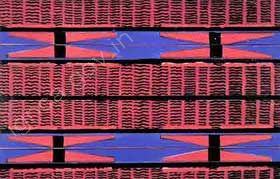
The decorative warrior shawl Tsungkotepsu is one of the most characteristic cloths of the Aos. This is an exclusive male shawl and could be worn only by one who has taken heads in war or offered mithun sacrifice (a feast of merit performed in Naga society by rich men). On a general dark base, the cloth has a median white band and on either side of it are horizontal bands of contrasting black, red and white. The median band is painted with a pattern in black which includes figures of mithun symbolizing wealth of the owner, elephant and tiger to symbolize valour of the man, human head representing success in head-hunting and a few other things like spear, dao and cock.
Another shawl worn on festive occasions by men of wealth of the sons and daughters of wealthy men is Aomelep su, in which dog’s hair dyed red is woven at regular intervals so as to make the shawl appear shaggy in spots. This shawl is woven in strips of red, yellow and black alternating.
Rongsu shawl is one of the most decorative Ao cloth and the most difficult to earn the right to wearing it, for it can be worn only by a man whose grandfather and father have both done the mithun sacrifice feast and who has done it himself.
The other shawls consist of Tiongkong su, Tabensa su, Lungkhum subang, Keyi su, and Bangmerem su.
The Ao women’s skirt consists of a cloth nearly one and a quarter metre long and about two thirds of the metre deep wrapped round the waist with the top outer corner tucked in just in front on of the left hip. It is impossible to describe all the varieties of skirts for they vary from village to village, phratry to phartry and even clan to clan in the same village. The Ao skirts include: Azu jangnup su mostly of red and black stripes with little yellow in the black stripes. Ngami su or fish tail skirt. Yongzujangau or cucumber seed skirt is woven in red on a black background.
Angami Nagas
The Angami are one of the biggest Naga tribes. They are a handsome and hardworking people living chiefly on the products of the fertile terraced fields generations ago on the hilly slopes and in the valleys around their villages, and by hunting. The Angami women are expert weavers. When there is no work in the fields, one can see them sitting at their simple looms for long hours, slightly bending forward, interlocking the horizontal threads of the weft with the stretched vertical threads of the warp have to be divided into two layers.
There are several varieties of cloths worn by the Angamis, the predominant pattern with white with red and black bands called Loramhoushu and black with red and yellow bands called lohe. The Angamis have only one cloth distinctive of social status namely phichu-pfe worn by the priest. Another kind of cheap shawl used by men and women for rough wear is a black shawl called ratapfe.
Men invariably wear a kilt, which is a plain black cloth. This kilt is generally embroidered with cowries in three or four lines, the real significance of which is rapidly changing. In olden days, three lines of cowries signified that the wearer was a warrior, and four lines of cowries signified that the wearer was a veteran of renown.
The cloths principally in vogue among the women are a plain blue cloth and a white cloth with black marginal bands of varying width, but they are more frequently seen wearing the men’s cloth. The ordinary dress of Angami women consists of a petticoat called neikhro, a sleeve less bodice called vatchi, a white skirt called pfemhou.
Ze-liangs-rong
The Ze-liangs-rong, a mixed group of Zemis, Liangmais and Rongmei wear a few varieties of clothes, the design of which do not basically differ from those of the Angamis. The general pattern is a white cloth having about six black bands at both edges. The sizes of the black bands are not same. While the cloths and skirts of the Zemei are white with a very narrow black and red border, women of the two other groups wear a variety of cloths, the designs of which do not until recently basically differ from those of the Angamis. From the homegrown cotton, they make shawls and skirts in white or beige, the original colours if their two varieties of raw cotton, with black bands of different widths on the border, separated by red and pink borders. These are for everyday use. For ceremonial attire Rongmei women have introduced intricate designs of many variations of line and colours, particularly for their skirts, belts and men’s sashes used for dancing in which they excel among other Naga tribes. The most popular dancing skirt is black with a wide, elaborately embroidered red border and three white median bands with a thin red line in the center.
Sangtam
The designs and symbols in the textiles of Sangtam Naga are mutandis similar to those of the Aos and Yimchungers. Sangtam Rongsu shawl is a warrior shawl, no ordinary people can wear. The cloth on a black base has four grey bands at the top and another four bands of the same colour at the bottom. Another decorative Sangtam shawl called Supong is supposed to be used by rich men. The Sangtam tsingrang su, design of which is said to have been revealed to a woman of Pongen clan in a dream, is another shawl of the man of Sangtam aristocracy alone.
Sema
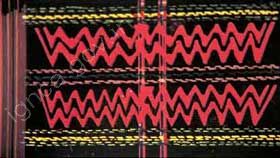
Different designs used in Sema textiles
Although weaving was comparatively less practiced in Sema villages than among the neighboring tribes, in recent years the Sema women have been producing shawls and skirts that have admired for their delicate colourful patterns even outside Nagaland.
One of the commonest Sema cloths, akhum, is black with three or four red bands. Akhum may be decorated with several designs and any be worn by rich men. Sema warriors of note wear a cloth called avi-kiyi-phi, which is a modification of meiphi and is very similar to the Lotha rakhusu. A rich Sema, who offered that feast of merit by killing mithun, may also wear this cloth. It is a white cloth with nine white bands of about at regular intervals.
In the white band are embroidered shapes and a pattern of ‘X’ lozenges in red woolen. In some of the Sema villages a handsome cloth of broad black and white strips called nisuphi is worn.
An ordinary cloth commonly worn by Sema women and girls without any restrictions is called lototsu.
Yimchunger
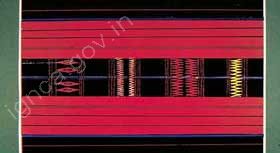
Middle portion of Yimchunger Shawl
The Yimchunger Nagas have a great variety of shawls. One of the most attractive shawls is called the rongkhim, which can be worn only by a warrior of great renown. The red colour in the shawl symbolizes the blood of the enemy. If this cloth is worn by any other man, who is not a warrior, he is believed to die of leprosy. Kechinger Ronfkhim is also a warrior shawl, but in order of merit, it denotes second rate honour. The man who takes the right hand of the slain enemy is entitled to wear this shawl and none other. It is a black cloth with narrow grey bands at two edges.
The tsungrem khim is an exclusive female shawl. There is a story as to how the design of this shawl came to the weavers.
Sangkonglim khim or long drum shawl can be worn by both man and woman without any restriction. It is a black shawl with a narrow white band in each of the three stripes. Amerthre khim is another attractive Yimchunger shawl, which can be worn only by a man who had killed a tiger. Rehuke khim or cowrie shawl is the most important cloth meant for the rich man of the Yimchunger tribe. One of the most common cloth used by both men and women without any restriction is a black shawl called Aneadk Khim. The next type of shawl commonly worn by male and female alike is Mokhok Khim. This shawl is worn by an ordinary person who is neither a warrior nor a rich man. The shawl is completely white having no design on it. Amurk Khim is another kind of shawl, which can be worn by both man and woman.
Yimchunger
Women wear mostly two kinds of skirts:
(a) Kechingperu khim is the first skirt given to a child when she requires one. It is a white cloth with narrow black and red bands at regular intervals alternating with the white.
(b) Alongza khim or Langa Imjung is a rich woman’s skirt.
Phom Nagas
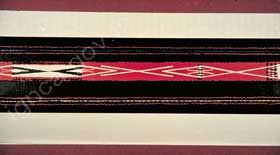
Dengas of the median bands of Phom Warrior Shawl
Phom Nagas also classify their clothes on the basis of their social status of the wearer. The ordinary cloth for rough wear may be a white in which they call Vihe-ashak or a dark blue called Nempong-ashak. A man who has taken human heads in war or has offered feast of merit as a recognition of his wealth in his village may wear a cowrie shawl called by the Phom fanet. In Naga society, cowrie is a symbol of marital status. Another handsome cloth, which the Phoms called the henyu, is a red shawl with narrow white horizontal bands at regular intervals. Rich men may wear this cloth. But in the recent years, this cloth has been selected as the National cloth for the Phom and now any person wears it without any restrictions. The general pattern of the Phom shawl is red with a broad median white band elaborately embroidered with red lozenges.
Phom women wear a skirt called Phom shungnang. This is a black cloth with two prominent and parallel stripes in each of which there are five narrow red lines. Wives and daughters of rich Phom may wear a white skirt called shaka.
Rengma
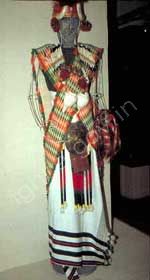
Naga Male dress
Rengma Naga cloths are also of various patterns. The difference of the various types of cloths are all the more important, particularly being indicative of the status and position of the weavers. A man who ahs not been able to offer any feast of merit nor ever taken an enemy head is entitled to wear an ordinary type of cloth called rhikho. It is white with four narrow black bands. This is worn by young and old alike, the only difference that the numbers of black bands are reduced. Another kind of cloth for which no ceremonies are required is a dark blue one with a very broad median band embroidered with a thin zigzag pattern in red at the edges. This is essentially a young man’s cloth. It is called the Moyet tsu.
Alungtsu is a cloth for well-to-do men. It is worn by men who have not yet offered a great feast of merit marked by setting up of monoliths. Teri Phiketsu is another Rengma shawl for which the performance of head hunting ceremony is essential.
Lotha
Lotha shawls are also of several patterns and indicate the number of social gennas performed by the weavers. The ordinary shawl of the Lotha is known as Sutam, a white cloth with broad dark blue horizontal stripes, which is worn by boys and men who have performed no social ‘gennas’. The phangrhup shawl can be worn by men who have performed the first social genna. There is no cloth assigned to be worn after performing the second social genna. The southern Lothas wear a cloth ethasu after performing the third social genna. Finally, a man who has completed a series of social genna by dragging a stone wears handsome cloth, which is called eshamsu.
The skirt of an unmarried girl is a plain bark blue one. On marriage, she wears a pretty skirt called loroesu, dark blue with big squares of narrow white and redlines giving a sort of tartan effect. When her husband has dragged a stone, she may change over to a skirt called lungpensu.
Konyak
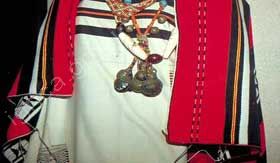
Female dress
The Konyaks have a few varieties of clothes. The Konyaks have a few varieties of clothes. A remarkable shawl worn by the village elders in important meetings and conferences is called nye-myon. Another white shawl worn by women is called Nikola. In the medium portion, there are two narrow black lines at a distance of nearly 4 cms between which a lozenge pattern in red is woven. Colorful and handsome shawl called shatni may be worn by rich konyak women. When a rich man’s daughter marries, it is their custom that she would be presented a shatni shawl by her parents, which she will simply preserve. This particular shawl would be used to wrap her body on death.
An aristocrat shawl generally used by the konyak chiefs (Ang) and elders of the village is called meyni. It is a combination of broad black and red bands alternately. Another shawl worn by village elders is called Hompani, which is nothing but a meyni cloth devoid of cowries and woolen fringes. Rich Konyaks wear a handsome cloth called nyauni, which is a combination of red bands and red lines.
Chaubandii-chaula upper garment of the Nepalese women.
Chaddar upper garment used by the Assamese women.
Dhora surwal the trouser used by the Nepali
Dhuti big white cloth with thin border used as a lower garment by Nepali.
Dhaka Topi a cap worn by the Nepali
Gamchha along cloth used as a turban among the Nepali people.
Gamosa small cloth used as a towel among the Assamese.
Gunyu the Nepali saree
Khamthang female shawl among the Kuki
Nvebenu term for male shawl among the Konyak.
Wankok lower garment of Mikir.
Thangnanglou Male shawl of the Kuki people.




